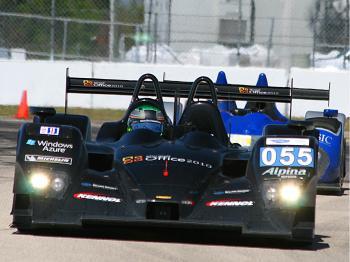
LMP2: #55 Level 5 Survives
Multi-series racing team Level 5 debuted in P2 with a win in the Sebring 12 Hours, but it was not a pretty win.Endurance racing is about endurance; while it is often a multi-hour sprint, as P1 and GT were this year, sometimes it is a battle to see who can make more repairs faster. Level 5 won in old-school fashion; mechanics did a great job to get the car back into the hands of the drivers.
IndyCar star Ryan Hunter-Reay drove the final stint for Level 5. “This is what endurance racing at the 12 hours of Sebring is all about—endurance,” he said. “This team has done an amazing job—I have never seen a group of guys work so hard in such a short time.
“For me growing up in Florida, winning Sebring is a dream come true. We knew this race was going to be about keeping the car clean and dealing with problems quick and efficiently.”
LMP2 is a much-modified, cost-controlled class for 2011, with new cars and new engines debuting at Sebring. The rules may need adjustment, as the new cars were not particularly fast nor durable.
Nominally, LMP2 cars should be just a tick slower than the LMP1’s but at Sebring the P2s finished behind the top three LMPCs and the top seven GTs. Even GTE-AM winner Tracy Krohn finished ahead of the first P2.
The fastest car by far in qualifying was the #26 Signatech Oreca 03-Nissan, using a brand new 3.4-liter Nissan V8. Several seconds down were the Level 5 Lolas, a coupe and an open car fielded by Scott Tucker. The Lolas also use a brand-new engine, the Honda twin-turbo V6. The other car in this tiny class was the #35 Oak Pescarolo powered by a 4-liter BMW-based Judd engine.
[etssp 286]The Signatech and the two Level 5 cars spent most of the race trading the class lead and fighting mechanical woes. Ryan Hunter-Reay in the #55 level 5 lost a wheel and about 20 laps repairing that. The #33 Level 5 spent time in the pits with suspension damage, possible picked up in a collision with the #35 Oak Racing car, which also spent time in the pits.
LMPC: Genoa Racing #036 Runs Flawless Race
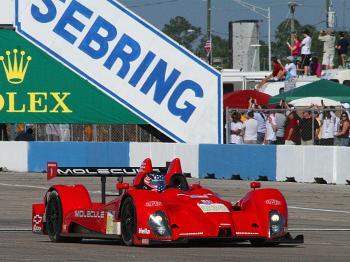
The pole-winning Genoa Racing #036 Oreca FLM09 drove a textbook race, avoiding accidents, escaping mechanical problems, and finishing 44 seconds ahead of the next car in class.
“We had the fastest car in the field going into the race. It was a textbook way to run a race: just click off laps—no penalties, no contact, none of that stuff. The team prepared such a solid car for us and we just went about our day,” explained winning driver Dane Cameron. “The team prepared such a solid car for us we never had to worry about a thing”
While Cameron makes it sound easy, his words do not disguise the fact that the team and drivers did everything right, which is itself a phenomenal achievement at Sebring.
Cameron and co-drivers Michael Guasch and Jens Petersen finished ninth overall, right behind the much faster P1 cars.
CORE Autosport made a great LMPC debut, finishing second and third in class. This team bought the old Level 5 cars over the off-season and put together a strong team of drivers to compete in LMPC in 2011.
At Sebring both cars ran well, (the #006 had power steering pump problems two hours in) led briefly, and by halfway had established themselves solidly in second and third.
[etssp 287]Genoa’s #063 Oreca finished fourth, despite losing three dozen laps because of a collision with a GT car and then a rear-end electrical problem which necessitated replacing the entire back end.
GTC: Black Swan Gets Its Sebring Win
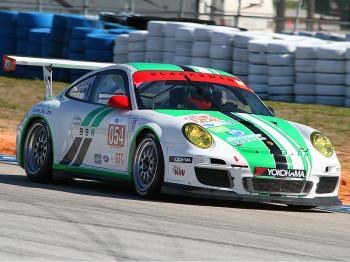
Tim Pappas’s Black Swan Racing Porsche won GTC by a third of a lap, beating a tough field of U.S. and international drivers. Black Swan won the 2010 GTC championship, but missed Sebring. This year they came to Sebring and got the win.
“Right now I’m in a little bit of haze,” Pappas said after the race. “I think it’s going to hit me tomorrow when I see that trophy again.”
Like many other teams, Black Swan didn’t get its car until 10 days before the race, and had to work feverishly to get ready.
“I am proud of the team,” Pappas continued. “To come down here and win was so unexpected because everything came together at the last minute.
GTE-AM: Attrition
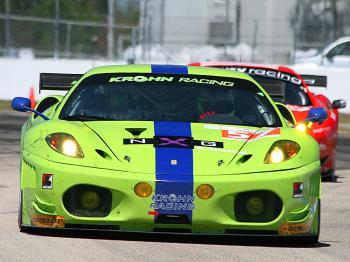
The GTE-AM class in a pro-Am class running cars at least one year old. Many of the cars are the same models raced by GT teams; the pro drivers are as talented as any others in the race. The difference is usually budget, preparation and experience.
Sebring is a tough challenge for Pro-Am teams, demonstrated by three of the five entries retiring.
Tracy Krohn’s #57 Ferrari F430 GT won by enduring. The nearest challenger, the pole-winning #63 Proton Porsche, finished 50 laps down. Krohn Racing, which participates in multiple series, fielded a reliable car it knew well, drove quickly and competently, and took the class victory.
We haven’t had a single mechanical issue; [we’ve been] trouble free,” Krohn said after the race. “The car hasn’t been behind the wall. These guys are professional and they just do it right.”
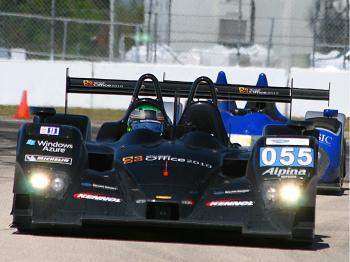





Friends Read Free